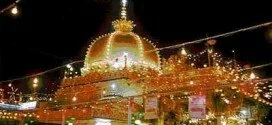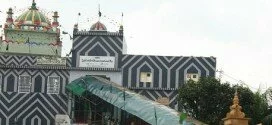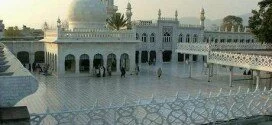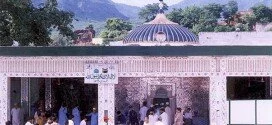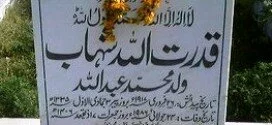Silsila: Junaidia Chishtia
Date of Wisaal: 1071 A.D.
Date of Urs: 19 Safar
Address: Data Darbar, Lahore, Pakistan
Description:
It is generally thought that in his lifetime the great saint was called as Gang 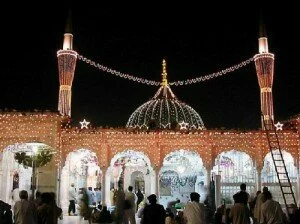 Bakhsh but after-wards he became too famous as ‘Data Gang Bakhsh’. Ali Hajvery (R.A.) was a Persian Sufi and a scholar. The greatest saint of the sub-continent born in Hajver, a town of Ghazni in Afghanistan, in 1000 A.D (400 H) and died in Lahore in 1063 or 1071A.D. In the course of his spiritual journey to God, he journeyed physically to many countries, including Turkistan, Transoxania, Iran, Iraq, and Syria where he met innumerable Sufis and Sheikhs, many of those have been mentioned in his book ‘Kashf-ul-Mahjoob’.
Bakhsh but after-wards he became too famous as ‘Data Gang Bakhsh’. Ali Hajvery (R.A.) was a Persian Sufi and a scholar. The greatest saint of the sub-continent born in Hajver, a town of Ghazni in Afghanistan, in 1000 A.D (400 H) and died in Lahore in 1063 or 1071A.D. In the course of his spiritual journey to God, he journeyed physically to many countries, including Turkistan, Transoxania, Iran, Iraq, and Syria where he met innumerable Sufis and Sheikhs, many of those have been mentioned in his book ‘Kashf-ul-Mahjoob’.
During the Urs the shrine and its whereabouts are beautifully lit. A large number of devotees from different parts of the country besides tens of thousands from the city will visit the Data Darbar to pay their homage by reciting verses from the Holy Quran, Qawalees, and recitation of Naats and poetry to the saint. Separate arrangements are made for women to visit the shrine. ‘Langer Khana’ (distributing free food) and milk Sabeel also attract a large number of people.
The tradition of milk-sabeels traces its roots to a time when the people of Lahore used to give tax in the form of milk to the city keeper Ray Raju Jogi. Legend has it that when Hazrat Data Gunj Baksh arrived in Lahore, he stopped them from this practice. As a result, their businesses flourished and followers began giving the milk to the saint to give to the needy. Today, milkmen continue the practice by donating milk to destitutes.
Sultan al-Hind Hazrat Khwaja Moeenuddin Chishti paid his homageto Data Ganj buksh in the following words:
“Ganj Bakhsh-e Faiz-e Aalam, Mazhar-e Noorr-i Khuda
Naqisaan Raa Peer-e Kaamil, Kaamilan Raa Rahnuma”
The bestower of treasure (Ganj Bakhsh) in both the worlds, the reflector of the splendor of God, An accomplished spiritual guide for the learned and a guide for the ignorant.
According to some historians one of the first persons to become Muslim at the hand of Hazrat Data Gang Bakhsh (R.A) was Rai Raju. He was Naib Hakim of Lahore at that time. On his conversion to Islam Hazrat Data Gang Bakhsh (R.A) named him Shaikh Hindi. There is likelihood that under his influence many other people also converted to Islam.
When Hazrat Data Ganj Bakhsh (R.A), came to Lahore, he built a ‘Khanqah’ and a Mosque, known as ‘Khishti Masjid’, outside the city on a mound to the west of Bhati Gate near the bank of river Ravi Lahore. It is said that when the mosque was originally being built by him some of the locals pointed out that the Qibla direction of the mosque is not in the right and appears towards south. On complaint, he asked the people to say prayer and during the prayer he showed them the Holy Kaaba, consequently its direction was right.
It was the first miracle of the saint. This mosque became a model to look at for the fixing of Qibla of all the mosques in the following centuries.
The historical records tell us that after the death of Hazrat Data Gang Bakhsh R.A, because of the reverence and respect of the Muslims for the great Saint, the mosque has been the subject of renovation, addition and beautification for several times by different devotees.
The great Mughal Emperor Akbar built the northern and southern massive gates and floor leading to the cenotaph. Later, in the third year of the reign of Emperor Mahyiudin Muhammad Aurangzeb Alamgir (1658-1707 A.D) an excessive flood in the River Ravi ruined the original mosque. So, keeping in view the need of mosque, within few days a new beautiful building of the mosque was built on the same foundation. The emperor also built an embankment that not only had been a major reason in saving Mosque ever after but also caused the river to change away its course further north.
Maharaja Rangit Singh (Nov.1780- June 1839) himself also had great respect for the Holy saint. He came to hold the shrine in great reverence and made many offerings. He contributed Rs. 10, 000 on the occasion of each Urs of the Hazrat Data Gang Bakhsh (R.A) and he also repaired the mosque periodically. After him Maharani Chand Chour (Wife of Kharak Singh and mother of Naunehal Singh) repaired the mosque and also built a beautiful vaulted chamber over the cenotaph where the Holy Quran was recited day and night.
The already existing mosque was a flat top building having minarets but without any dome. In 1860 AD, Gulzar Shah, a Kashamirian, rebuilt the mosque on the same pattern. It was for the first time that he also built a huge dome in its center with two other small domes on its right and left. There were also low height minarets at the corners. In1879 A.D the mosque was again repaired by Jhando chob Farosh. Some people say that there was no dome over the mausoleum of Hazrat Data Gang Bakhsh (R.A), in 1868 A.D Haji Muhammad Noor built a dome over the mausoleum.
The recorded events revealed that, in 1921 A.D under the supervision of Ghulam Rasol Khatwala, a major operation was exercised here when in place of the earliest modest mosque a pretentious building was constructed here but it was damaged in late 1960 A. D during an earthquake. The Punjab Auqaf Deparment took the charge of the shrine and the mosque in 11 January 1960 A.D.
As there was rapidly increase in number of visitors so the government decided to embark upon an ambitious two phases expansion plan of the Mosque. In 1978 A. D, the phase one (western side of the shrine) was completed under the supervision of General Zia-ul-haq. The mosque was shifted from its original place further towards west. The second phase (eastern side of the shrine) was begun in 1997 A.D under the direction of former Prime Minister Mian Muhammad Nawaz Sharif that has completed now. It is divided into four parts on Mughal Chahar Bagh pattern. On completion, the project would have a double storey complex consisting of a basement for parking vehicles, a Sama Hall, Ablution site, Toilets, Administrative block, Atiqaaf rooms, Langer Khana, Library, Madressa, Industrial School, Quran Mahal and A/C plants. The upper storey consists of a square prayer chamber, the mausoleum, the Chillaghah of Hazrat Khawaja Muinudin Chishti (R.A) and a wide courtyard.
The facade of the prayer chamber is a magnificent arched structure raised in blue tiles with two high cone style minarets that are gold plated. On the south, in front of the mausoleum, there are two doors. The Shah of Iran donated one of these doors that has beautiful Iranian inlaid work on gold. All the arches, the window frames and pillars in the mosque and mausoleum are in carved marble. The entire floor is also in marble. The mosque is spread over a total area of 3,68,150 sq. ft. and it is the third largest mosque in Pakistan. It can accommodate up to 52,600 people.
View Google Map of Data Ganj Bakhsh R.A

